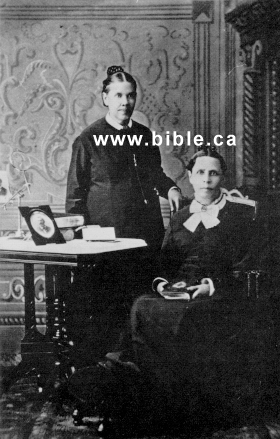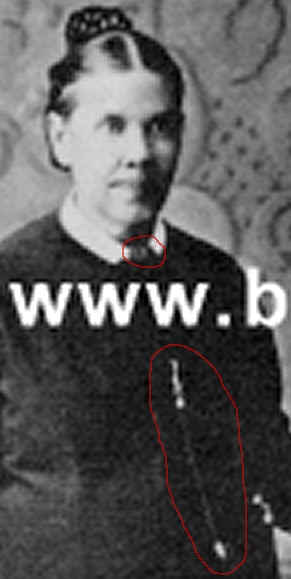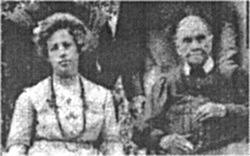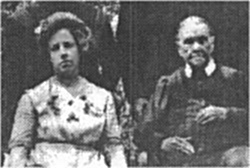Did Ellen White Wear Jewelry?
By Sydney Cleveland and Dirk Anderson
| "A Picture is Worth a Thousand Words" |
|---|

"A fantastic dress, a display of gold chains and gaudy laces, is a certain indication of a weak head and a proud heart."
|
Mrs. White condemned the wearing of jewelry as idolatry against God:
"The Lord God of heaven calls upon man to put away their idols, to cut off every extravagant desire, to indulge in nothing that is simply--for display and parade, and to study economy in purchasing garments and furniture. Do not expend one dollar of God's money in purchasing needless articles. Your money means the salvation of souls. Then let it not be spent for gems, for gold, or precious stones."1
Mrs. White makes it clear God is calling on Adventists to "put away their idols" of jewelry that are used "for display and parade". Could it be that Ellen White, while telling others to put away their jewelry, was herself indulging in the "idols"?
On the right is a photograph of Ellen White with her twin sister Elizabeth at age 51. Notice that Ellen is displaying a decorative brooch on her collar and is parading a decorative chain. This photograph was taken 15 years after she condemned others for wearing similar "idols" of jewelry:2
"To dress plainly, abstaining from display of jewelry and ornaments of every kind, is in keeping with our faith."3
Mrs. White said she was "pained" to see the youth wearing golden chains and that it was a sign of "religious declension":
"I have marked with pain your religious declension and your disposition to trim and ornament your apparel. Some have been so unfortunate as to come into possession of gold chains or pins, or both, and have shown bad taste in exhibiting them, making them conspicuous to attract attention."4
One might ask, What about Mrs. White wearing of a golden chain? Was it a sign of religious declension in her life? Let us give Sister White the benefit of the doubt. Perhaps she made one slip-up for a private photo, but as a practice, did she really wear jewelry in public? To answer that question, we need to ask the eyewitnesses. In his defense of Ellen White, Adventist author Herbert E. Douglass, writes:
"In 1957-1959, Horace Shaw, long-time professor of speech at Emmanuel Missionary College (Andrews University), developed a list of 366 people who had heard Ellen White speak. He asked them to recall her platform manner, whether the event was public or private, what impressed them most, and what they remembered about her message."5
Notice what the eyewitnesses said regarding her appearance:
"Twenty-nine referred to her dress material, describing it as 'black velvet or silk,' 'two-piece garment,' 'dress did not seem to adorn her, she seemed to adorn the dress.' As an accent to the black, Mrs. White often wore white cuffs and collar. Other accessories mentioned were a 'gold watch chain' with a 'silver watch in her pocket, and a simple brooch.'"6
The eyewitnesses indicate Mrs. White adorned herself with a gold watch chain, silver watch, and brooch. Contrast this with her rebuke of an Adventist woman who wore jewelry:
"In answer, the lady displayed a gold ring on her finger, given her by an unbeliever, and said she thought it no harm to wear such ornaments. 'We are not so particular,' said she, 'as formerly. Our people have been overscrupulous in their opinions upon the subject of dress. The ladies of this institution wear gold watches and gold chains, and dress like other people. It is not good policy to be singular in our dress; for we cannot exert so much influence.' We inquire, Is this in accordance with the teachings of Christ? Are we to follow the Word of God, or the customs of the world?"7

|
|
This is a 400% magnification of the above scanned-in photo from the James White Memorial Library. The brooch, worn at the neck, and the golden decorative chain, circled in red, can be clearly seen. |
According to Mrs. White, those who wear "golden chains" are not "in accordance with the teachings of Christ."
The mere fact that Mrs. White sat for a photograph is also contrary to what she taught:
"This making and exchanging of photographs is a species of Idolatry. Satan is doing all he can to eclipse heaven from our view. Let us not help him by making picture-idols. We need to reach a higher standard than these human faces suggest. The Lord says, 'Thou shall have no other Gods before me.'"8
Many Adventists are surprised to learn that Mrs. White wore jewelry and made photographs in private, while at the same time telling her followers that God was displeased with such activities. The fact that she engaged in activities so opposed to her own testimonies could lead one to question whether she really believed that what she wrote came from God. Did she really have confidence in her own testimonies? Or did she know then what many Adventists are just finding out today, that her testimonies did not originate with God at all, but originated in the teachings of the strong personalities around her? Perhaps these testimonies were written to support the teachings of Adventist leaders, but deep in her heart, Mrs. White did not really believe they came from God. This might explain why she advocated certain teachings in public, but did not follow them in her private life.
--Ellen White, Manuscript Releases Vol. 19, p. 31
SDAs Doctor the Photographs
| Distorting Reality | |
|---|---|

| 
|
| Real picture | Faked picture |
In the following pictures take note of the one on the left. It is the original photo of an elderly Mrs. White sitting with her granddaughter, Ella Robinson, for a group photo. On the right is the retouched photo that appears in the SDA Church's book Ellen G. White, The Later Elmshaven Years. Notice that Ella's necklace is noticeably absent.
Apparently the White Estate is not only adept at altering the words of Ellen White but they are also proficient at altering photographs. The alteration is necessary in order to perpetuate the myth that early SDA's did not wear jewelry and paid heed to the testimonies of Ellen White.
Sister White Acknowledges Wearing Expensive Jewelry
Notice the following quote where Mrs. White acknowledges receiving a costly piece of jewelry and wearing it repeatedly:
"Sister Kerr took me into her parlor bedroom, and opened a box of ruches [A STRIP OF LACE, NET, RIBBON, OR THE LIKE, USED IN PLACE OF A COLLAR OR CUFF] for the neck, and desired me to accept the entire box. Her husband is a merchant in Honolulu, and though not a believer, he is a very liberal man. She also presented me with three yards and a half of silk, costing three dollars a yard with which I was to make a sack. [A SHORT COAT OR JACKET FITTING SOMEWHAT LOOSELY] I saw that she was very desirous that I should have this, and I could not refuse without greatly disappointing her. It was beautiful silk left from a dress which she had. She also gave me a silk scarf, and a ten dollar pin, composed of white stones, very plain and serviceable. I thought I could not accept this, but she looked so sorry, that I finally did take it, and have worn it ever since, for it is handy and becoming, while it is not showy at all."9
Note: A "ten dollar pin" in 1891 is equivalent to a $288 pin in 2019.10 This could hardly be considered a cheap piece of jewelry. In 1890 the average female laborer received a salary of $4.50 per week.11 Therefore, a ten dollar pin represents more than two weeks of pre-tax wages.
One must wonder why Mrs. White did not rebuke Sister Kerr for not giving the money to the poor. After all, in an earlier "testimony", Mrs. White resoundly condemned her followers for spending money on jewelry instead of giving it to the poor:
"God calls upon the young to deny themselves of needless ornaments and articles of dress, even if they cost but a few dimes, and place the amount in the charity box. He also calls upon those of mature age to stop when they are examining a gold watch or chain, or some expensive article of furniture, and ask themselves the question: Would it be right to expend so large an amount for that which we could do without or when a cheaper article would serve our purpose just as well? By denying yourselves and lifting the cross for Jesus, who for your sakes became poor, you can do much toward relieving the suffering of the poor among us; and by thus imitating the example of your Lord and Master, you will receive His approval and blessing."12
Finally, let us contrast Mrs. White's practice of wearing jewelry with what she wrote:
"The ornamentation of the person with jewels and luxurious things is a species of idolatry. ... Expensive dress and adornments of jewelry give an incorrect representation of the truth that should always be represented as of the highest value."13
Perhaps we should heed what is written in the Didache, an early Christian document believed to have been written around the first century A.D. The Didache advises early Christians on one sure method of identifying a false prophet:
"If any prophet teaches the truth, yet does not practice what he teaches, he is a false prophet."14
Citations
1. Ellen White, Welfare Ministry, p. 267.
2. Photograph taken in 1878 at Battle Creek, Michigan. Photo is on file at the James White Research Library, Andrews University. The digitally scanned image of Ellen White and her twin sister wearing jewelry was provided by www.bible.ca. Another digitized version of the same photograph is available from the Loma Linda University Library's web site, although the image is smaller and the tone appears to have been altered to diminish the presence of the chain somewhat. The images of Ellen White's granddaughter were scanned in from the book White-Washed by Sydney Cleveland. For more photos of Ellen White and her family wearing jewelry, please get Pastor Cleveland's 233-page book.
3. Ellen White, Testimonies, Vol. 3, p. 366.
4. Ibid., pp. 366-367.
5. Herbert E. Douglass, Messenger of the Lord: The Prophetic Ministry of Ellen G. White, chapter 12.
6. Ibid.
7. Ellen G. White, Evangelism, p. 271.
8. Ellen White, Messages to Young People, p. 316. For more Ellen White quotes on the idolatry of photography, Click Here.
9. Ellen White, Letter 32a, 1891, pp. 2, 3. To J.E. and Emma White, December 7, 1891. Parenthetical quotes, in caps, were supplied by the White Estate.
10. The Morgan Inflation Calculator. What cost $10 in 1891 would cost $288.08 in 2019.
11. "Work and the American Dream" by Linda Maynard, © 2005 by the Yale-New Haven Teachers Institute. http://www.yale.edu/ynhti/curriculum/units/1980/6/80.06.06.x.html.
12. Ellen G. White, Testimonies Vol. 4, p. 511.
13. Ellen White, Bible Training School, May 1, 1908.
14. Didache, 11:10
